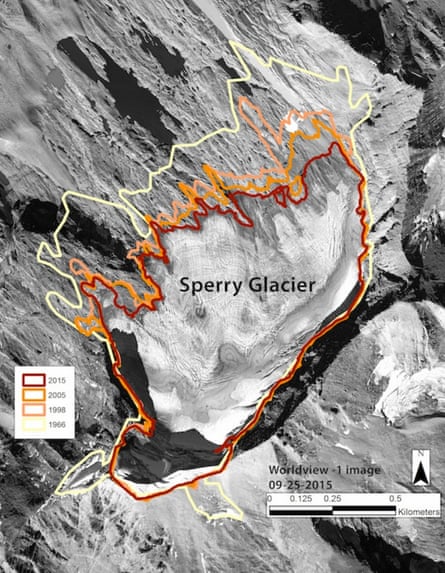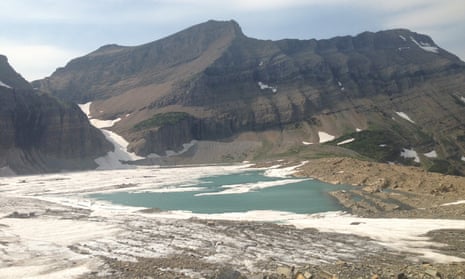It’s now “inevitable” that the contiguous United States will lose all of its glaciers within a matter of decades, according to scientists who have revealed the precipitous shrinkage of dozens of glaciers in Montana.
Warming temperatures have rapidly reduced the size of 39 named glaciers in Montana since 1966, according to comparisons released by the US Geological Survey (USGS) and Portland State University. Some have lost as much as 85% of their expanse over the past 50 years, with Glacier national park, site of 37 of the surveyed glaciers, set to lose all of its eponymous ice formations within the next few decades. Of the 150 glaciers that existed in the park in the late 19th century, only 26 remain.
The disappearance of glaciers in Montana is part of a broader loss that will see all glaciers, defined as moving bodies of snow and ice larger than 25 acres, largely vanish from the lower 48 states of America by the mid point of the century, according to Dr Daniel Farge, lead USGS scientist.
“It’s inevitable that we will lose them all over the next few decades,” Farge said. “The Colorado glaciers started melting before Montana’s and while there are larger glaciers in the Pacific north-west that will hold on longer, the number vanishing will steadily grow until none are left.”

Andrew Fountain, a geologist at Portland State, added: “While the shrinkage in Montana is more severe than some other places in the US, it is in line with trends that have been happening on a global scale.”
Rising temperatures – Montana is warming nearly twice as quickly as the global average – and changes in precipitation patterns are eroding away glaciers in the state and elsewhere along the Rocky mountains. Last year, scientists in Colorado found that the Arikaree glacier, which is likely more than 1,000 years old, has been thinning by around a metre (3.2ft) a year over the past decade and will vanish within 25 years.
Warming winters are bringing more rain, rather than glacier-forming snow, to Montana and other states. Even when there is plenty of snow, as Montana experienced this winter, the increasing heat of spring and summer is melting it away more quickly. Spring snow melts are now occurring at least two weeks earlier than they were in the 1960s.
Scientists analyzed the extent of the 39 Montanan glaciers by studying aerial and satellite imagery stretching back to 1966. The latest data, from 2015, shows that there are now just 26 glaciers larger than 25 acres. The largest, Harrison glacier, is now 410 acres – a 19% decrease over the past 50 years. Others have declined by up to 85%.
Glaciers have been in this stretch of the northern Rockies for around 7,000 years and the study of tree ring data and piles of rocks left behind by shifting glaciers show there were around 150 of the ice formations in the Glacier national park area in 1850. Most have now disappeared.
Farge said glaciers started to shrink from around 1910 and then entered “rapid and continual” melting from the 1970s onwards. The environmental conditions now experienced in the region are a marked departure from historical norms.
“The glaciers have waxed and waned with different climate fluctuations but this is the first time they are heading for almost certain extinction,” Farge said.
“This is the first time in 7,000 years they’ve experienced this temperature and precipitation. There’s no hope for them to survive. We’d need a major reversal where it would get cooler, not just stop getting warmer. There’s nothing to suggest that will happen.”
Farge said the decline of the glaciers outlined in the research is probably conservative as it focuses upon the extent of the glaciers, not the volume. Thinning glacier ice may cover a reasonable area but is particularly vulnerable to further warming and melting.
Last year, 2.9m people visited Glacier national park. Future tourists will be confronted by a vista devoid of glaciers, a loss that Farge said will be “poignant”.
“We hope that loss contributes towards a dialogue about what to do about it,” he said. “It’s important that the data is out there and is being discussed.”

According to Nasa, the world’s glaciers have lost around 400bn tons of ice per year since 1994, a decline that has impacted wildlife, increased wildfire risk in places and contributed to rapid sea level rise.

Comments (…)
Sign in or create your Guardian account to join the discussion